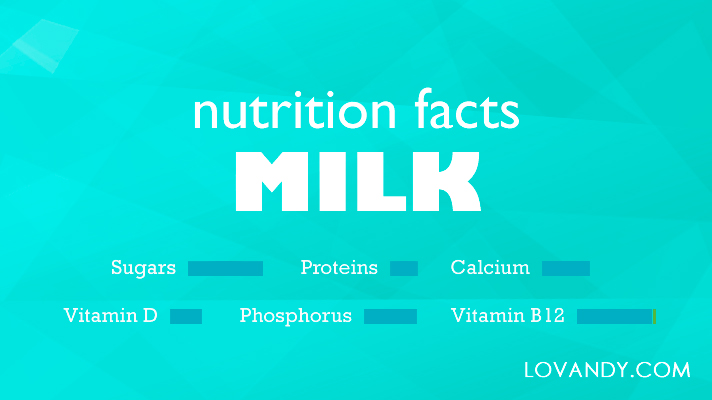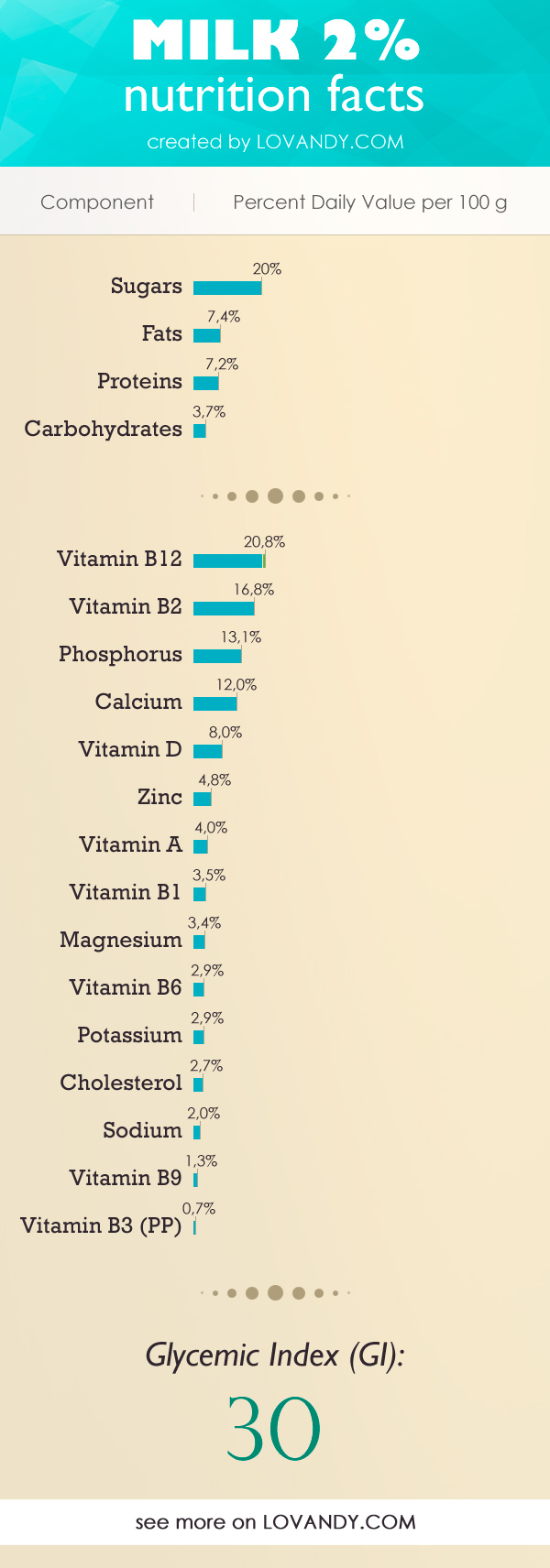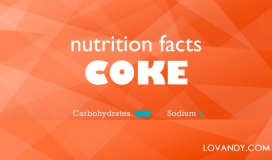Milk is a complete food product due to its easy digestibility. Moreover, milk stimulates the assimilation of nutrients from other foods. So, what is so unique in milk content? Let us find out!
Whole Milk Nutrition – More Than 120 Different Components
Every year in the world more than 500 million liters of milk are drunk, the consumption of which contributes variety to food, improves tastes of other products. Milk has therapeutic and prophylactic properties. The main value of milk in nature is to provide nutrition to the newborn.
The nutritional and biological value of milk is higher than that of other products found in nature. It contains more than 120 different components, including 20 amino acids, 64 fatty acids, 40 mineral substances, 15 vitamins, dozens of enzymes etc. That is why the most important task for manufacturers is to preserve the natural properties of milk and to deliver them without changing to a consumer.
Considering mentioned, whole milk is the best variant, as it is almost not thermally treated. You cannot store it for long, but the benefits are all there.
Milk contains up to 1% of mineral substances that are more than 50 elements. The main ones are calcium, phosphorus, magnesium, potassium, sodium, chlorine and sulfur.
Microelements in milk (iron, copper, silicon, selenium, tin, chromium, lead etc.) are associated with the shells of fat balls (Fe, Cu), casein and whey proteins (Fe, Cu, Zn, Mn, Al, I, Se etc.). These elements are stored in enzymes and vitamins. They provide the construction and activity of vital hormones necessary for metabolism in the body.
Find out more about milk:
Milk contains all vitally important vitamins, but some in insufficient quantities. The content of vitamins depends on season of the year, breed of animals, quality of feed, conditions of storage and processing of milk. That is why whole milk contains the most vitamins, since it might not be pasteurized or sterilized.
Nutrition Facts (Glycemic Index = 32)
| Name of nutrition component | Content per 1 cup | Content per 100 g | Percent of daily intake* |
|---|---|---|---|
| Proteins | 8.0 g | 3.2 g | 6.9% |
| Fats | 8.3 g | 3.3 g | 12.2% |
| Carbohydrates | 12.0 g | 4.8 g | 3.7% |
| Sugars | 12.8 g | 5.1 g | 20.4% |
| Calcium | 283 mg | 113 mg | 11.3% |
| Iron | 75 µg | 30 µg | 0.2% |
| Magnesium | 25 mg | 10 mg | 3.1% |
| Phosphorus | 210 mg | 84 mg | 12.0% |
| Potassium | 330 mg | 132 mg | 2.8% |
| Sodium | 107 mg | 43 mg | 1.9% |
| Zinc | 925 µg | 370 µg | 4.7% |
| Vitamin A | 115 µg | 46 µg | 6.5% |
| Vitamin B1 | 115 µg | 46 µg | 4.2% |
| Vitamin B2 | 422 µg | 169 µg | 15.4% |
| Vitamin B3 (PP) | 222 µg | 89 µg | 0.6% |
| Vitamin B6 | 90 µg | 36 µg | 2.7% |
| Vitamin B9 | 13 µg | 5 µg | 1.3% |
| Vitamin B12 | 1.3 µg | 0.5 µg | 20.8% |
| Vitamin C | – | – | – |
| Vitamin D | 0.25 µg | 0.1 µg | 0.7% |
| Vitamin K | 0.75 µg | 0.3 µg | 0.3% |
| Fatty acids, saturated | 4.68 g | 1.87 g | as low as possible |
| Fatty acids, monounsaturated | 2.02 g | 0.81 g | 2.7% |
| Fatty acids, polyunsaturated | 0.48 g | 0.19 g | 1.6% |
| Cholesterol | 25 mg | 10 mg | 3.3% |
How Much Fat is there in Whole Milk?
Fat in whole milk is contained in an amount of 2.8% to 5%. Milk fat consists of a complex mixture of glycerides. Of the several thousand triglycerides of milk fat, most are multi-acid, so fat has a relatively low melting point and a uniform consistency.
Whole milk is considered the most filled with fat, since its content is not lowered artificially.
Among saturated acids, palmitic, myristic and stearic (60-75%) ones prevail, among unsaturated – oleic acid (about 30%). The content of stearic and oleic acids rises in summer, but myristic and palmitic – in winter. These acids have highly valuable biological properties; they are used for cells formation and development.
Skimmed Milk (0.1% fat) Nutrition Facts (Glycemic Index = 25)
Factors forming quality are associated with the processing of milk, which is carried out immediately after milking. It is filtered and cooled to as low as possible positive temperatures. Timely cooling of milk helps to extend the shelf life of the product. At factories, milk is checked for organoleptic indicators, acidity and fat content. Accepted milk is cleaned of mechanical impurities, then normalized by fat.
Skimming of milk causes the decomposition of lactose with the formation of carbon dioxide and acids – formic, lactic, acetic etc. Due to the denaturation of the protein shells of fat balls, fat burns.
Insufficient heat treatment leads to incomplete inactivation of milk enzymes that cause unwanted biochemical processes in milk and dairy products. The result may be a decrease in the quality, flavor and nutritional value of it. That is why you should buy milk only in authorized stores and supermarkets.
Anyway, modern technologies allow manufacturers to make the fat content of any value. You can find milk that fits your diet. It may even be 0.1% fat. Of course, this leads to a lowered caloric content as well.
| Name of nutrition component | Content per 1 cup | Content per 100 g | Percent of daily intake* |
|---|---|---|---|
| Proteins | 8.5 g | 3.4 g | 7.4% |
| Fats | 0.3 g | 0.1 g | 0.4% |
| Carbohydrates | 12.3 g | 4.9 g | 3.8% |
| Sugars | 12.0 g | 4.8 g | 19.2% |
| Calcium | 510 mg | 204 mg | 20.4% |
| Iron | 100.0 | 40 µg | 0.2% |
| Magnesium | 28 mg | 11 mg | 3.4% |
| Phosphorus | 252 mg | 101 mg | 14.4% |
| Potassium | 415 mg | 166 mg | 3.5% |
| Sodium | 130 mg | 52 mg | 2.3% |
| Zinc | 1000 µg | 400 µg | 5.0% |
| Vitamin A | 342 µg | 137 µg | 19.6% |
| Vitamin B1 | 90 µg | 36 µg | 3.3% |
| Vitamin B2 | 350 µg | 140 µg | 12.7% |
| Vitamin B3 (PP) | 220 µg | 88 µg | 0.6% |
| Vitamin B6 | 100 µg | 40 µg | 3.1% |
| Vitamin B9 | 13 µg | 5 µg | 1.3% |
| Vitamin B12 | 1.0 µg | 0.4 µg | 16.7% |
| Vitamin C | 2.5 mg | 1 mg | 1.3% |
| Vitamin D | 3.0 µg | 1.2 µg | 8.0% |
| Vitamin K | – | – | – |
| Fatty acids, saturated | 0.300 g | 0.120 g | as low as possible |
| Fatty acids, monounsaturated | 0.118 g | 0.047 g | 0.1% |
| Fatty acids, polyunsaturated | 0.018 g | 0.007 g | 0.06% |
| Cholesterol | 5 mg | 2 mg | 0.7% |
Semi Skimmed Milk Nutrition Facts (2% fat) (Glycemic Index = 30)
Semi skimmed milk is probably the most popular one. Its fat content varies, so we will consider the one with 2%. It is rather hard to compare this kind of milk with fully skimmed, since the technology used is particularly the same. This means there is more fat, but vitamins and minerals are on the same level.
The content of semi skimmed milk is also close to a whole. However, during the heating process, denaturation of whey proteins occurs and milk acquires the taste of a boiled product or the taste of pasteurization. As a result, the amount of calcium decreases due to the formation of poorly soluble calcium phosphate.
| Name of nutrition component | Content per 1 cup | Content per 100 g | Percent of daily intake* |
|---|---|---|---|
| Proteins | 8.3 g | 3.3 g | 7.2% |
| Fats | 5 g | 2.0 g | 7.4% |
| Carbohydrates | 12.0 g | 4.8 g | 3.7% |
| Sugars | 13 g | 5.0 g | 20.0% |
| Calcium | 300 mg | 120 mg | 12.0% |
| Iron | 50 µg | 20 µg | 0.1% |
| Magnesium | 28 mg | 11 mg | 3.4% |
| Phosphorus | 230 mg | 92 mg | 13.1% |
| Potassium | 350 mg | 140 mg | 2.9% |
| Sodium | 118 mg | 47 mg | 2.0% |
| Zinc | 950 µg | 380 µg | 4.8% |
| Vitamin A | 70 µg | 28 µg | 4.0% |
| Vitamin B1 | 98 µg | 39 µg | 3.5% |
| Vitamin B2 | 463 µg | 185 µg | 16.8% |
| Vitamin B3 (PP) | 230 µg | 92 µg | 0.7% |
| Vitamin B6 | 95 µg | 38 µg | 2.9% |
| Vitamin B9 | 13 µg | 5 µg | 1.3% |
| Vitamin B12 | 1.3 µg | 0.5 µg | 20.8% |
| Vitamin C | 500 µg | 200 µg | 0.3% |
| Vitamin D | 3.0 µg | 1.2 µg | 8.0% |
| Vitamin K | 0.5 µg | 0.2 µg | 0.2% |
| Fatty acids, saturated | 3.13 g | 1.25 g | as low as possible |
| Fatty acids, monounsaturated | 1.40 g | 0.56 g | 1.8% |
| Fatty acids, polyunsaturated | 0.18 g | 0.07 g | 0.6% |
| Cholesterol | 20 mg | 8 mg | 2.7% |
How Much Calcium is there in Milk
Salts of calcium are of great importance not only for humans, but also for milk processing. For example, an insufficient amount of calcium salts causes slow rennet coagulation of milk in the production of cheeses, and their excess may cause the coagulation of milk proteins during sterilization. About 22% of all milk calcium is associated with casein; the rest is made up of salts.
In 1 liter of milk, there are 1.2 g of calcium, which is necessary for bones formation and blood pressure regulation.
The difference between whole and skimmed milk in calcium content is actually insufficient. There might be even slightly more in a fully skimmed one. Nevertheless, as we have mentioned, whole milk is better, as calcium there is stored as is, not being precipitated.
Magnesium performs the same role as calcium, and occurs in the same salts in milk. Sodium and potassium are contained in the form of salts (ions), and some of them are associated with casein and shells of fat balls.
How Much Protein is there in Milk
Proteins are the most valuable part of milk. They make up about 3.2% of whole milk content, including casein 2.7%, albumin 0.4%, globulin 0.12%. The amount for a skimmed milk is a bit less with 3%, which is not significant.
Milk proteins contain all essential amino acids and are fully valuable.
Casein refers to complex proteins of phosphoproteins and is contained in the form of calcium salt (calcium caseinate). It gives milk white color. Whey proteins in the content of essential amino acids (lysine, tryptophan, methionine, threonine) are the most biologically valuable part of milk proteins, important for nutrition purposes. The main of them – lactoalbumin and lactoglobulin – have a high content of growth and protective substances. In cow’s milk, these proteins account for 18% of total proteins.
How Many Carbs are in Milk
The carbohydrates content for different milk (whole or skimmed) is almost equal. Lactose (milk sugar) is the main carbohydrate of milk; monosaccharaides (glucose, galactose, etc.) are present in it in a smaller amount.
Disaccharide lactose is the main source of energy for biochemical processes in the body (it accounts for about 30% of the energy value of milk). It promotes the absorption of calcium, phosphorus, magnesium and barium.
In milk, lactose is in the free state as a- and p-forms. A very small portion of lactose is bound to other carbohydrates and proteins. Milk sugar slowly penetrates the intestinal wall and gets to the bloodstream, so it is used to feed lactic acid bacteria that heal the stomach environment.
So, milk is one of the most beneficial natural products. It can grant you a whole lot of valuable elements and vitamins. Moreover, many of them are actually unique. That is why almost every diet has milk in a daily ration. You simply cannot find anything to replace it. In addition, there are many dairy products out there, and each of them is unique too.














